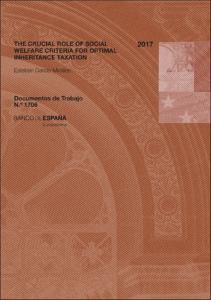Full metadata record
| DC Field | Value |
|---|---|
| dc.contributor.author | García Miralles, Esteban |
| dc.date.accessioned | 2019-08-10T18:13:39Z |
| dc.date.available | 2019-08-10T18:13:39Z |
| dc.date.issued | 2017-02-21 |
| dc.identifier.issn | ISSN: 1579-8666 (en línea) |
| dc.identifier.uri | https://repositorio.bde.es/handle/123456789/7255 |
| dc.description.abstract | En este artículo se calibra el impuesto óptimo a las herencias derivado por Piketty y Saez (2013) mostrando que diferentes supuestos sobre la función de bienestar social dan lugar a tipos óptimos muy dispares, que varían desde tipos negativos (cuando el criterio de bienestar social es utilitarista) hasta tipos positivos y elevados (incluso suponiendo que la motivación del donante es de tipo joy of giving). También se calibra el tipo óptimo por percentiles de herencia recibida, como hacen Piketty y Saez, pero teniendo en cuenta la heterogeneidad en riqueza y rentas del trabajo. El resultado es que el tipo impositivo óptimo desde la perspectiva de quienes no reciben ninguna herencia varía significativamente, en contraste con el tipo impositivo constante que obtienen Piketty y Saez |
| dc.description.abstract | This paper calibrates the full social optimal inheritance tax rate derived by Piketty and Saez (2013) and shows that different assumptions on the form of the social welfare function lead to very different optimal inheritance tax rates, ranging from negative (under a utilitarian criterion) to positive and large (even assuming joy of giving motives). The paper also calibrates the optimal tax rate by percentile of the distribution of bequest received, as Piketty and Saez do, but accounting for heterogeneity in wealth and labor income. The result is that the optimal tax rate from the perspective of the non-receivers varies signifi cantly, contrary to the constant tax rate obtained by these authors |
| dc.format.extent | 21 p. |
| dc.language.iso | en |
| dc.publisher | Banco de España |
| dc.relation.ispartof | Documentos de Trabajo / Banco de España, 1706 |
| dc.rights | Reconocimiento-NoComercial-CompartirIgual 4.0 Internacional (CC BY-NC-SA 4.0) |
| dc.rights | In Copyright - Non Commercial Use Permitted |
| dc.rights.uri | https://creativecommons.org/licenses/by-nc-sa/4.0/deed.es_ES |
| dc.rights.uri | http://rightsstatements.org/vocab/InC-NC/1.0/ |
| dc.subject | Imposición óptima |
| dc.subject | Herencias |
| dc.subject | Criterios de bienestar social |
| dc.subject | Optimal taxation |
| dc.subject | Inheritance |
| dc.subject | Social welfare criteria |
| dc.title | The crucial role of social welfare criteria for optimal inheritance taxation |
| dc.type | Documento de trabajo |
| dc.identifier.bdebib | 000358421 |
| dc.identifier.bdepub | DTRA-201706-eng |
| dc.subject.bde | Impuestos y otros ingresos públicos |
| dc.publisher.bde | Madrid : Banco de España, 2017 |
| dc.subject.jel | H21 |
| dc.subject.jel | H23 |
| dc.subject.jel | H24 |












